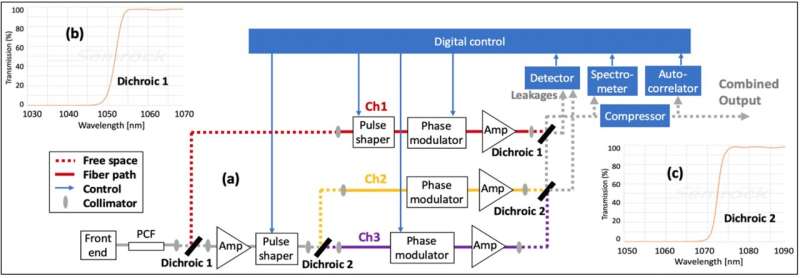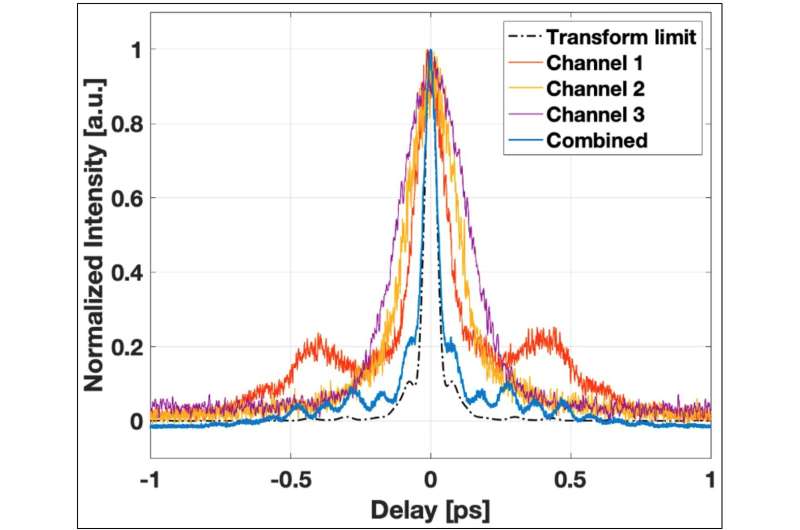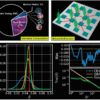A team of researchers from the Accelerator Technology & Applied Physics (ATAP) Division at Berkeley Lab has developed a new technique for combining fiber lasers operating at different wavelengths to produce ultrashort laser pulses. The research was published in the journal Optics Express.
The work could advance the development of laser-plasma accelerators (LPAs), which have the potential to push the frontiers of high-energy physics and enable discoveries in materials science, fusion research, and many other areas.
LPAs use intense, ultrafast laser pulses passing through a plasma to accelerate charged particles up to a thousand times faster than current technologies. They promise more compact and powerful machines that are less expensive to build and operate than conventional accelerators.
Currently, most LPAs use laser pulses with repetition rates of only a few Hertz (Hz); however, realizing the full potential of LPAs “will require high-power laser systems capable of generating ultrashort, high-energy laser pulses at repetition rates in the kHz range or higher,” says Siyun Chen, a Research Scientist at ATAP’s BELLA Center, who led the experimental demonstration of the new technique.
These constraints, adds Chen, place very demanding requirements on the laser systems that generate such pulses. So, the researchers turned to fiber lasers, which she says are the “most efficient high-power laser technology demonstrated to date and also have extensive industrial development that could be leveraged in our work.”
Although the energy and power of pulses produced by fiber lasers can be scaled up by combining multiple pulses in space (spatially) and in time (temporally), these pulses, however, are currently limited to about a hundred femtoseconds (fs), which are not short enough to drive LPAs.

(a) Experimental setup; (b) Dichroic mirror 1 transmission spectrum; and (c) Dichroic mirror 2 transmission spectrum. © Berkeley Lab
“While fiber laser systems offer the highest wall-plug efficiencies—the electrical-to-optical power efficiency—the spectrum of ultrashort laser pulses amplified in these systems narrows,” explains Tong Zhou, a Research Scientist in ATAP’s BELLA Center who led the development of the new technique.
“This gain narrowing is a fundamental effect when laser pulses are amplified in this way; the narrower the pulse’s spectrum is, the longer its duration. Consequently, it is very challenging for high-power fiber lasers to generate pulses shorter than about a hundred fs.”
However, by spectrally combining multiple laser pulses operating at adjacent wavelength ranges, the team, which also included Qiang Du from the Engineering Division and Dan Wang and Russell Wilcox from ATAP, achieved an ultra-broad combined spectrum able to support very short pulses at tens of fs.
To increase the bandwidth and produce tens-of-fs-long pulses, the researchers first used a mode-locked oscillator and ytterbium-doped fiber amplifier (YDFA) to generate pulses of 120 fs at 100 MHz repetition rates. These were sent to a photonic-crystal fiber, where their spectrum was broadened from 27 nanometers (nm) to 90 nm.
They then used a dichroic mirror, which allows laser pulses to be separated or combined without appreciable intensity loss, to split the pulse spectrally. These were then sent to two pulse shapers to shape the intensity and phase of the respective pulse spectra. While the reflected pulses were sent to the first shaper, the transmitted pulses were amplified by the YDFA, pulse-shaped by the second shaper, and further split by another dichroic mirror. The three chirped pulses from the fiber laser were then amplified and recombined using additional dichroic mirrors.

Measured autocorrelation traces after compression (combined pulse and pulse from each channel) and calculated autocorrelation trace of the transform-limited pulse for the combined spectrum. © Berkeley Lab
“This ultra-broadband spectral combining with synthesized pulse shaping produced pulses of only 42 fs in duration, which is significantly shorter than the pulses generated from each of the three fiber channels,” says Chen. “We believe this is the shortest pulse duration ever achieved from a spectrally combined ytterbium fiber laser system.”
Zhou notes, “While the work has demonstrated ultrafast pulses that are so far at low energy, it demonstrates the key principles of ultra-broadband spectral combining and coherently spectrally synthesized pulse shaping and provides a path forward for using fiber lasers to drive LPAs.”
The team plans to add more amplification stages and implement multidimensional techniques capable of spatially, temporally, and spectrally combining fiber lasers to produce high-energy, tens-of-fs laser pulses.
Commenting on the work, ATAP Division Director Cameron Geddes says, “It shows how researchers at ATAP are driving the development of advanced particle accelerators that promise discoveries in fundamental scientific research and breakthroughs in fusion, medicine, material science, and many other areas.”
More information:
Siyun Chen et al, Broadband spectral combining of three pulse-shaped fiber amplifiers with 42fs compressed pulse duration, Optics Express (2023). DOI: 10.1364/OE.486884
Provided by
Lawrence Berkeley National Laboratory
Citation:
Spectrally combining lasers could unleash the potential of laser-plasma accelerators (2023, July 24)



